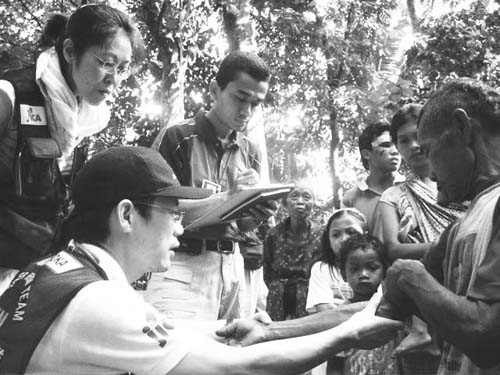Japan's Official Development Assistance White Paper 2006
Main Text > Part II ODA DISBURSEMENTS IN FISCAL YEAR 2005 > Chapter 1 Japan's ODA in Terms of Disbursements
Chapter 1 Japan's ODA in Terms of Disbursements

Medical activities after the May 2005 Earthquake Disaster in Central Java (Photo: JICA)
Key Points
- In 2005 (calendar year), Japan's ODA disbursements amounted to about US$13.15 billion, up 47.3% from the previous year. The increase was largely due to debt relief for Iraq and debt referrals for Indonesia. Excluding them, disbursements marked a decrease of 4.1% from the previous year.
- Breaking down Japan's ODA disbursements, bilateral ODA accounted for 79.2% of the total, and ODA channeled through multilateral organizations comprised 20.8%.
Chart II-1 Japan's ODA Disbursements in 2005

Japan's Official Development Assistance (ODA) disbursements in 2005 totaled approximately US$13,146.58 million, a 47.3% increase from the previous year (on a yen basis, approximately ¥1,447.4 billion, a 50.1% increase from the previous year). Bilateral ODA disbursements were approximately US$10,462.1 million, a 75.9% decrease from the previous year, while ODA provided through international organizations totaled approximately US$2,740.37 million, an 8.8% decrease from the previous year.
The ODA budget for Japan peaked in 1997 and has now decreased by 35%. Amidst this trend, the ODA disbursements in 2005 significantly exceeded approximately US$8,922.46 million in 2004. The major reasons for this were debt relief (approximately US$3,220.92 million / ¥354.6 billion) for Iraq, as well as debt payment deferrals (approximately US$1,341.52 million / ¥147.7 billion) implemented for Indonesia as part of support for the earthquake off the coast of Sumatra. Excluding these, the ODA disbursements in 2005 totaled approximately US$8,584.14 million (approximately ¥945.1 billion, a 3.8% decrease from the previous year).
Breaking down Japan's ODA disbursements, bilateral ODA accounted for 79.2% of the total, and ODA through international organizations comprised 20.8%. Bilateral ODA is expected to contribute to strengthening relations between Japan and the recipient countries, since assistance projects were implemented after consultations with the developing countries. The advantages of ODA through international organizations are that it utilizes the abilities and knowledge possessed by international organizations, ensuring political neutrality, and it provides assistance to countries and regions that government-based assistance can hardly reach. In light of this, Japan is making efforts to flexibly utilize both responses through bilateral means and collaboration with international organizations to ensure that assistance is provided appropriately.
Breaking down bilateral ODA, disbursements recorded as grant aid were approximately US$6,523.62 million (approximately ¥728.3 billion, a 53.7% increase from the previous year), comprising 49.6% of total ODA disbursements. Out of this, debt cancellation was approximately US$4,775.69 million (approximately ¥525.8 billion, a 97.9% increase from the previous year), which accounted for 36.3% of the total disbursement. Excluding debt cancellation, Japan provided a total of approximately US$1,747.93 million (approximately ¥192.4 billion, an 8.5% increase from the previous year) in grant aid, comprising 13.3% of the total disbursements. The implementation of the aforementioned debt reductions for Iraq and debt cancelations through the Enhanced Heavily Indebted Poor Countries (HIPC) Initiative are included among the reasons for debt cancellation accounting for one third of Japan's total ODA disbursements (see page 111 for details on the Enhanced HIPC Initiative). Technical cooperation amounted to approximately US$2,671.06 million (approximately ¥294.1 billion, a 4.8% decrease from the previous year), loan aid and other ODA credits amounted to roughly US$1,211.53 million (approximately ¥133.4 billion, approximately ¥264.6 billion increasing from the previous year), and loan aid, etc., excluding debt cancellation amounted to US$2,433.77 million (approximately ¥268 billion, a 138.1% increase from the previous year), comprising 20.3%, 9.2%, and 18.5% of the total disbursement, respectively.
Looking at bilateral ODA (including for Eastern Europe and ODA graduated countries) by region shows that Asia received 36.6% of the total at approximately US$3,841.09 million (approximately ¥422.9 billion), which included debt relief of approximately US$8 million (approximately ¥0.9 billion), and the Middle East received 33.2% of the total at approximately US$3,479.22 million (approximately ¥383.1 billion), which included debt relief of approximately US$3,221.78 million (approximately ¥354.7 billion). Debt relief accounts for the majority of bilateral ODA to the Middle East. Africa received 10.8% of the total at approximately US$1,137.34 million (approximately ¥125.2 billion), which included debt relief of approximately US$123.88 million (approximately ¥13.6 billion), Latin America and the Caribbean received 4.0% at approximately US$415.02 million (approximately ¥45.7 billion), which included debt relief of approximately US$82.17 million (approximately ¥9 billion), and Oceania received 0.9% at approximately US$96.97 million (approximately ¥10.7 billion) with no debt relief. Europe received 3.1% at approximately US$320.61 million (approximately ¥35.3 billion), which included debt relief of approximately US$117.62 million (approximately ¥13 billion).
Chart II-2 Trends in Japan's ODA Budget and Other Major Expenditures (Initial Budget Base)

Chart II-3 Trends in Bilateral ODA Disbursements by Region

Chart II-4 Trends in the ODA Disbursements of Major DAC Countries

Chart II-5 Ratio of ODA Disbursements to GNI in the DAC Countries

Chart II-6 Per Capita ODA Disbursements in the DAC Countries

Chart II-7 Trends in Japan's ODA Disbursement and Its Ratio to GNI

Chart II-8 Amount of Japan's Assistance to Least Developed Countries in Japan's Bilateral Assistance

Chart II-9 Ratio of Grants to LDC in Japan's Bilateral Assistance



 Next Page
Next Page